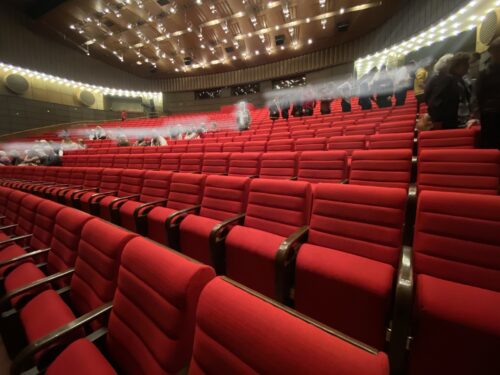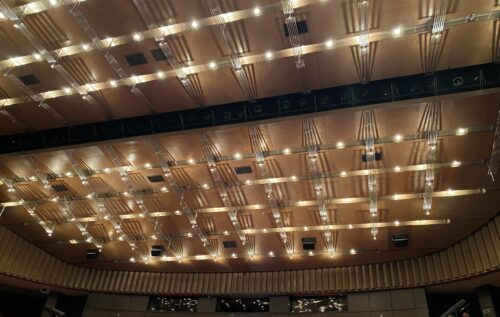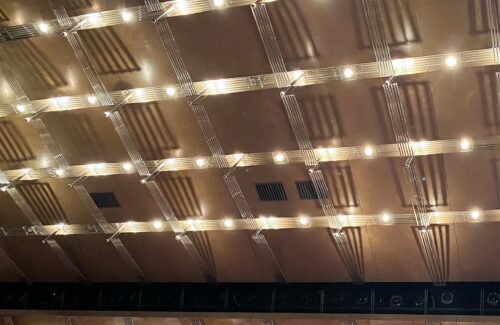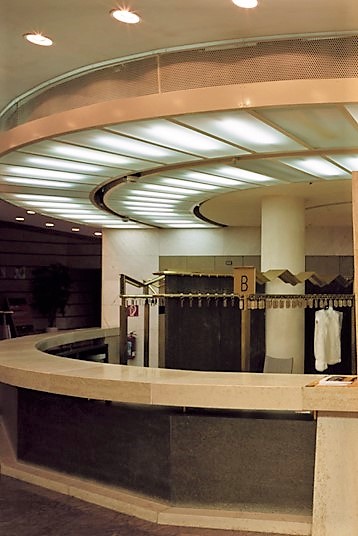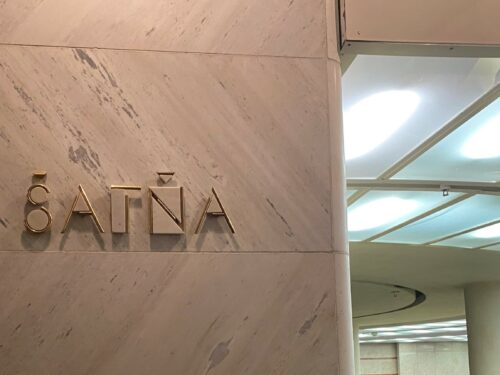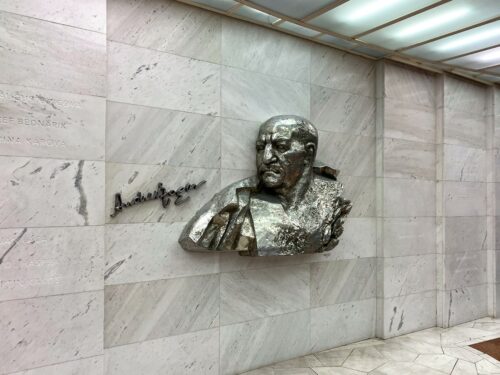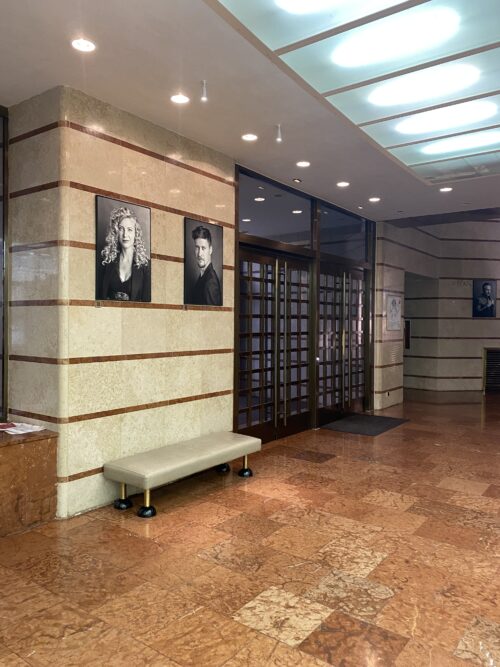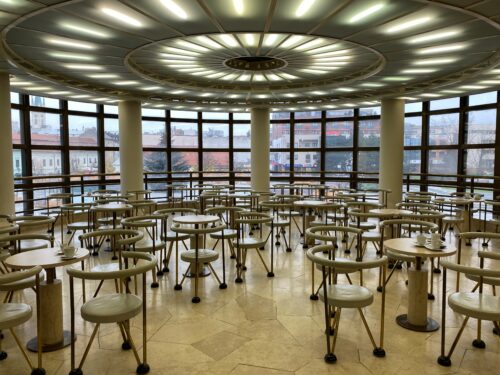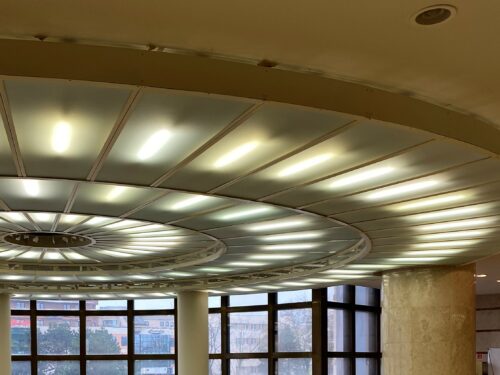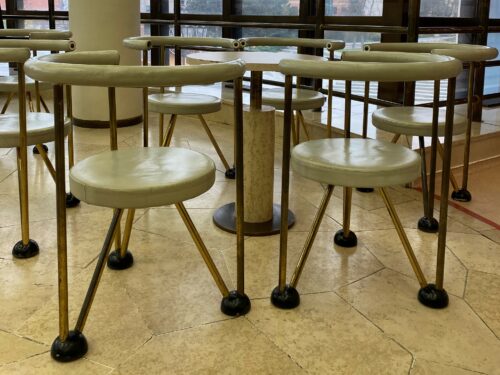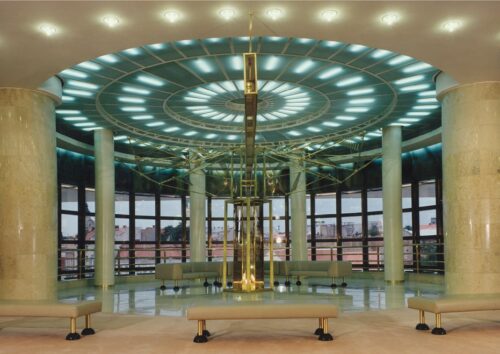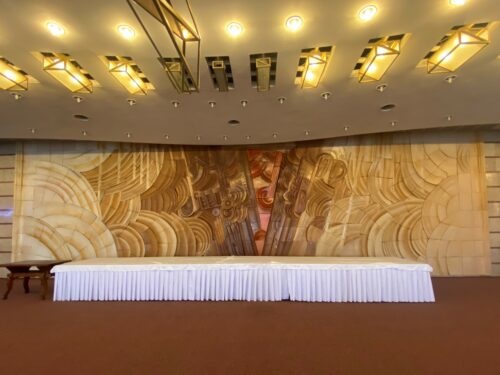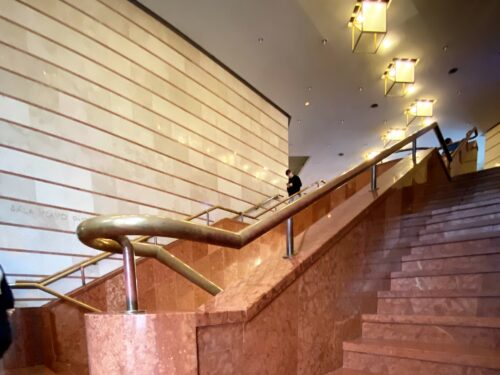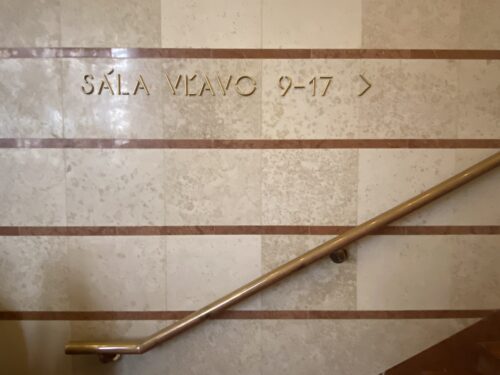Andrej Bagar Theatre
Category: Cultural institutions
Architects: Juraj Hlavica, Márius Žitňanský, Štefánia Rosincová
Interior design: Juraj Hlavica, Márius Žitňanský, František Kalesný, Ľubomír Mihálik
Works of art: Tibor Bártfay, Marián Prešnajder, Katarína Šujanová, Juraj Marth
Location: Svätoplukovo námestie 4, Nitra
Design: 1981–1983
Built in years: 1982–1992

The monumental mass of the theatre shows the features of late modernism and postmodernism manifested in both exterior and interior architecture and in the design of the interior elements. The building´s importance and qualities have been emphasised from the beginning by the high standard of theatre technology, dimensions, and stage equipment offering attractive performances to the spectators. The building consists of two interconnected parts, the main one housing the drama hall and the adjacent one housing the experimental studio. Each mass has a separate, architecturally accentuated entrance, characterised by the partial rounding of the façade walls. In line with the trends of the time, the authors attributed a dominant role to both the halls and the lobby spaces, which include the cloak rooms for visitors, the theatre bar and the café with a restaurant.
Denisa Kramárová, who was interested in examining the interiors of the lobbies, described them using the following words, “The main feature of the three-level lobby is the use of marble and red travertine stone facing in combination with lamps and sculptures made of polished brass and milky glass. The ochre-red colour dominates the entire interior of the lobby space of the theatre. The large-scale marble wall facing is horizontally divided by linear strips of dark red travertine, which was also used on the floors in a regular rectangle grid. To visually define the space, in some parts the travertine was replaced by polished marble in irregular polygonal formats which can be seen for example under architectural sculptures or in the cloakroom area. On the upper floors, there is a fitted red carpet used for acoustic reasons. In the interiors, several interior elements bearing postmodern features have been preserved to this day. Worth mentioning are the furnishings of the theatre café: chairs with leather upholstery, brass-plated legs with distinctive black feet as well as round tables with metal-made legs and marble tabletop. One cannot forget to mention also the polished brass cover grilles with regular horizontal articulation, covering the heating system built into the niches.” [5]
The drama hall, with a capacity of 577 seats, is one of the three largest theatre halls in Slovakia. The exclusive suspended ceiling consisting of brass elements and acoustic boards compositionally complement curved rows of seats. An artistically and technically remarkable part of the drama hall is the stage with two side semi-stages, a height adjustable 14m x 14m stage floor, a cassette stage turntable with a diameter of 12.3 m and a coulisse height of up to 12 metres. [2] The experimental studio, with a capacity of 100–150 visitors and an octagon-shaped floor, was a true experiment at the time of its creation. It can be mainly proven by the still existing centre stage with its hexagon-shaped raisable platforms, offering many possibilities for three-dimensional transformation of the stage area. [3]
In their design, the authors assigned an important role to lights understood as important artistic artefacts of the interior. Geometrically shaped light objects made of brass and frosted glass dominate the lobby areas; the entrance hall and the theatre café feature timeless light panels surrounded by a series of dot lights. The lighting system in the theatre hall is also unique and together with the suspended ceiling generates illusionary visual experiences. The lighting is still given a lot of attention, as evidenced by its recent modernisation including the installation of sophisticated LED systems, offering new creative possibilities in the creation of scenic effects.
The theatre in Nitra is an excellent example of a building literally “intertwined” with works of art. The interior of the entrance hall is complemented by a sculptural relief of Andrej Bagar by Tibor Bártfay, which is surrounded by the names of important actors, stage directors, and dramaturgs carved in marble. The sides of the staircases are decorated by the most interesting costumes designed by the theatre’s costume designers. The lobby of the top floor is decorated by a large-scale ceramic sculpture “Ode to Joy, Culture and Harvest” by Juraj Marth, the guest lounge includes a textile work of art with motifs of William Shakespeare’s plays by Katarína Šujanová. The rich collection of art treasures includes the ceremonial curtain of the Great Hall depicting the Great Moravian scene with Svätopluk by Marián Prešnajder, which, thanks to its dimensions of 9.5m x 16.5m, is considered to be the largest hand-woven tapestry in Central Europe. [2, 4]
“Different interconnected layers of lighting, exclusive surface materials and many spectacularly illuminated interior elements give the individual spaces a scenic atmosphere which attracts the visitors already in the entrance area and allows them to tune into the atmosphere of the theatre world. One has to assess positively the preservation of the original character of the interior as well as its individual elements. There have been no reconstructions or renovations that would have disturbed its visual character, and the modernisation so far has been carried out with due respect for the original architecture.” [5]
- Dlhánová, Viera: Divadlo Andreja Bagara. Dejiny. [The Theatre of Andrej Bagar. The History.] Web portal of the European Theatre Architecture. Available at: https://www.theatre-architecture.eu/sk/db/?theatreId=214
- Budovu Divadla A. Bagara aj oponu zapísali do zoznamu pamätihodností Nitry. [The building of the A. Bagar theatre and its curtain included into the list of sights of the town of Nitra.] Web portal of MY Nitra. Available at: https://mynitra.sme.sk/c/22668349/budovu-divadla-a-bagara-aj-oponu-zapisali-do-zoznamu-pamatihodnosti-nitry.html
- Dlhánová, Viera: Architektúra a história výstavby novej budovy / O divadle / Scény divadla / História divadla. [Architecture and history of the new building. / About the theatre / Scenes of the theatre / History of the theatre.] Web portal: DAB. Available at: https://www.dab.sk/architektura-a-historia-vystavby-novej-budovy / https://www.dab.sk/o-divadle / https://www.dab.sk/sceny / https://www.dab.sk/historia-divadla
- Plastický reliéf Andreja Bagara / Stena slávy Divadla Andreja Bagara v Nitre / Slávnostná opona s veľkomoravským výjavom so Svätoplukom. [Sculptural relief of Andrej Bagar / The wall of fame of the Andrej Bagar Theatre / The curtain depicting the Great Moravian scene with Svätopluk.] Web portal: Divadelné prechádzky. Available at: https://divadelneprechadzky.theatre.sk/nitra/rZeXxg8Pgm/qzDXwaz2pd/
- Kramárová Denisa: Budova Divadla Andreja Bagara. Nitra. [The building of the Andrej Bagar Theatre in Nitra.] Seminar paper for the Selected Chapters course. Interior, Winter Term 2022–2023
Denisa Kramárová


